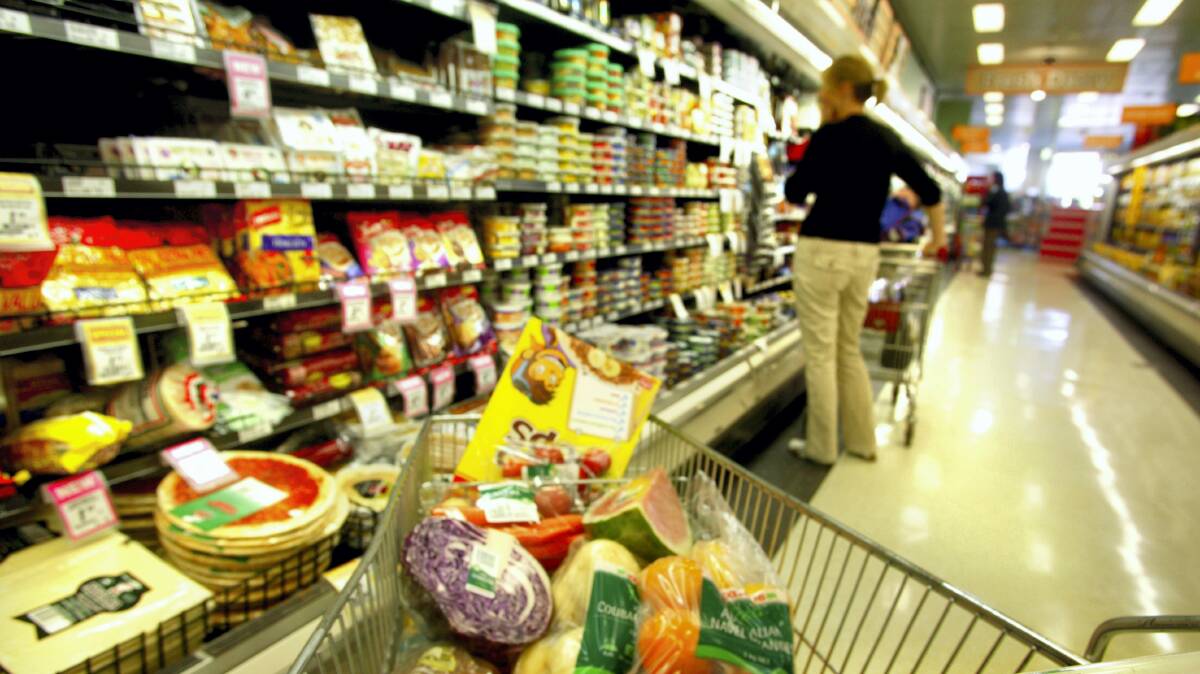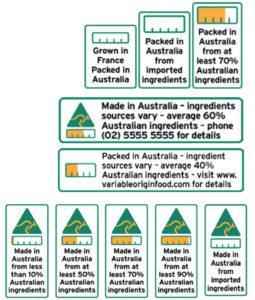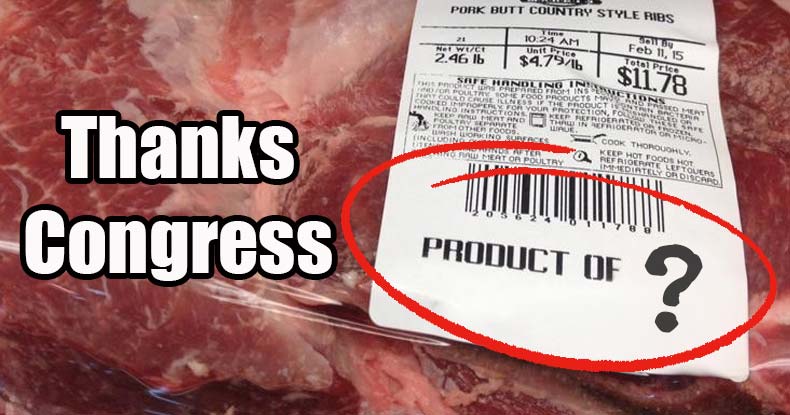41 is country of origin required on food labels
Country of Origin Food Labelling Rules New Country of Origin of Food labelling rules now apply for single ingredient, unprocessed fresh and thawed foods. Under the new regulations, businesses that supply and advertise these types of food items must disclose the country (or ocean) of origin so that customers can easily identify where their food was grown, raised, caught or harvested. Food labelling: country of origin - GOV.UK If all these activities took place in a single country, the label 'Origin: [name of country]' is acceptable. For the GB market, 'United Kingdom' is the origin label for beef and veal from both GB...
› rules-regulations › coolCountry of Origin Labeling (COOL) Frequently Asked Questions What is COOL? Country of Origin Labeling (COOL) is a consumer labeling law that requires retailers (most grocery stores and supermarkets) to identify the country of origin on certain foods referred to as “covered commodities”. The 2002 and 2008 Farm Bills and the 2016 Consolidated Appropriations Act amended the Agricultural Marketing Act of 1946 to require retailers to notify their ...

Is country of origin required on food labels
Country of origin food labelling | ACCC Country of origin food labelling If you sell or supply food for retail sale in stores, markets, online or from vending machines it is likely that you will be required to comply with the Country of Origin Food Labelling Information Standard 2016 (Standard). Types of food covered by the standard Label requirements The labels › country-of-originCountry of Origin Requirements in the United States: An Overview Apr 27, 2022 · The purpose of the Country of Origin marking is to inform consumers about the country where the product was manufactured. Here are some examples: Made in the United States; Made in China; Made in Vietnam; Made in Brazil; In the United States, the Country of Origin must be permanently affixed in most consumer products such as: Apparel and ... Food labelling | New Zealand Government Food labelling. Food labels help you make informed choices about the products you buy. The Ministry for Primary Industries website has information about food labelling. Find out what each part of the label means and what to do if you find a problem with a food label. How to read food labels. [L1]
Is country of origin required on food labels. Country of origin food labelling | business.gov.au Country of origin labelling is not required on the following food products: foods not for human consumption (for example, pet food) foods sold in restaurants, cafes, take-away shops or schools foods sold at fundraisers foods sold from the same premises in which they have been made and packed. Origin labelling - Food Safety Origin labelling of the primary ingredient of a food: Article 26 (3) of Regulation (EU) No 1169/2011 requires that where the origin of a food is given and is different from the one of its primary ingredient, the origin of the primary ingredient shall be given or at least indicated as being different to the origin of the food. Country of Origin Food Labeling | Jenn David Design The Country of Origin Labeling requirement states that "Food labeling statements regarding geographical origin must not be false or misleading in any particular." So it would be incorrect to state that the cocoa is a product of both Mexico and Chile on the label. You would need two labels in this case—one for each respective country of origin. Country of origin food label responsibilities | Your rights, crime and ... Country of origin food label responsibilities. The Country of Origin Food Labelling Information Standard 2016 (Standard) commenced on 1 July 2016 under the Australian Consumer Law (ACL). From 1 July 2018, if you are a business offering food products for retail sale in Australia, you must comply with the Standard. The type of label required for ...
business.gov.au › Products-and-services › ProductCountry of origin food labelling resources | business.gov.au May 21, 2021 · The specific origin label required for your food product will be determined by whether it: is a priority or non-priority food; was grown, produced, made or packed in Australia. There are two types of origin label: the standard mark; a country of origin statement. Packaging and labelling | Food Standards Agency Food businesses must include a business name and address on the packaging or food label. This must be either: the name of the business whose name the food is marketed under; or. the address of the business that has imported the food. Food products sold in NI must include a NI or EU address for the food business. How to Navigate the Country of Origin Food Labelling Requirements — Lau ... Requirements that must be met before the Australian country of origin labels can be used. When a food is grown, produced in, packed or made in Australia, it is mandatory that proportion of Australian content be disclosed. Where businesses cannot accurately identify the percentage of Australian content in a food, the claim that the food contains ... Country of origin of food - Ministry of Business, Innovation and Employment The Consumers' Right to Know (Country of Origin of Food) Act (the Act) was passed in 2018. The Act required the Minister of Commerce and Consumer Affairs to recommend a consumer information standard (to be made via regulations) by 4 June 2021. On 10 May 2021 the Consumer Information Standards (Origin of Food) Regulations 2021 (the Regulations ...
› Details › F2017C00920Country of Origin Food Labelling Information Standard 2016 Sep 28, 2017 · This is a compilation of the Country of Origin Food Labelling Information Standard 2016 that shows the text of the law as amended and in force on 12 August 2017 (the compilation date). The notes at the end of this compilation (the endnotes) include information about amending laws and the amendment history of provisions of the compiled law. Country of Origin Labeling of Agricultural Products While the COOL law contains an expressed exclusion for an ingredient in a processed food item, many imported items still must be labeled with country of origin information under the Tariff Act of 1930. Items that are imported in consumer-ready packages also are required to be labeled with country of origin information. inspection.canada.ca › food-label-requirementsGuidelines for "Product of Canada" and "Made in Canada" claims the Canada organic logo is an indication of organic certification to the Safe Food for Canadians Regulations. On imported products that are qualified to use the Canada organic logo, a country of origin statement or the statement "Imported" is required to be in close proximity to the logo, to avoid misleading consumers Mandatory country-of-origin labeling (US) - Wikipedia For country of origin labeling in general, see Country of origin § Labelling requirements. Country of origin labeling (COOL) (or mCOOL [ m for mandatory]) is a requirement signed into American law under Title X of the Farm Security and Rural Investment Act of 2002 (also known as the 2002 Farm Bill), codified at 7 U.S.C. § 1638a as Notice of ...
Origin Labeling Requirements for Imported Commodities Passed Tuesday, June 15, 2021 We have previously reported on proposed Senate legislation that would require country of origin labeling (COOL) for imported commodities sold online. On June 8, 2021, the...
Country-of-Origin Labeling for Foods - HSDL Many retail food stores are now required to inform consumers about the country of origin of fresh fruits and vegetables, seafood, peanuts, pecans, macadamia nuts, ginseng, and ground and muscle cuts of beef, pork, lamb, chicken, and goat. The rules are required by the 2002 farm bill (P.L. 107- 171) as amended by the 2008 farm bill (P.L. 110-246).
› consumer › labellingCountry of origin labelling - Food Standards The Australian Government introduced a country of origin food labelling system under Australian Consumer Law on 1 July 2016. Country of origin labelling requirements for food is in the Country of Origin Food Labelling Information Standard 2016, under the Competition and Consumer Act 2010. These requirements became mandatory on 1 July 2018.
Country of Origin Labels are required On Certain Foods Country of origin labeling is a consumer labeling law required on certain foods. As the list grows, bookmark the FAQ website above to see what foods require this type of labeling. 1-800-882-5104
Chapter 13 - Country of Origin Marking | U.S. Customs and Border Protection In the United States, the marking statute, Section 304, Tariff Act of 1930, as amended (19 U.S.C. 1304) requires that, unless excepted, every article of foreign origin (or its container) imported into the U.S. shall be marked with its country of origin. Paragraph 1 of Annex 311 of the NAFTA provides that the NAFTA parties shall establish ...
CPG Sec. 560.200 Country of Origin Labeling - FDA CPG Sec. 560.200 Country of Origin Labeling BACKGROUND: A statement of the country of origin on the labeling of imported foods is not required by the Federal Food, Drug, & Cosmetic Act. This is a...
New changes to Country of Origin Food Labelling, taking place throughout Australia | SBS Your ...
Which foods are covered in the country of origin labeling law? Foods that must be labeled with their country of origin are: 1. Muscle cuts of beef (including veal), lamb, pork, goat, and chicken; 2. Ground beef, ground lamb, ground pork, ground goat, and ground chicken; 3. Wild and farm-raised fish and shellfish; 4. Perishable agricultural commodities (fresh and frozen fruits and vegetables); 5.
Country of origin | ACCC You will find country of origin labelling on most food you buy at the supermarket, local stores, markets, online or from a vending machine. Food bought from restaurants, cafes, take-away shops, schools and caterers does not have to be labelled. Food that was packaged and labelled on or before 30 June 2018 can still be sold without the new labels.
Country of Origin Labeling (COOL) | Agricultural Marketing Service Country of Origin Labeling (COOL) is a labeling law that requires retailers, such as full-line grocery stores, supermarkets and club warehouse stores, to notify their customers with information regarding the source of certain foods.
USDA Eases Country Of Origin Label Rules To Redistribute Foodservice ... In an effort to provide flexibilities to support the nation's food supply amid the COVID-19 national emergency, the U.S. Department of Agriculture's Agricultural Marketing Service is temporarily relaxing country of origin labeling requirements to allow food products intended for foodservice to be sold in retail establishments.
Commerce Commission - Country of origin of food Country of origin of food. From 12 February 2022, businesses must disclose where certain fresh and thawed food comes from that they supply, offer, or advertise for supply to consumers in New Zealand. The requirement to disclose only applies to cured pork products and single-ingredient fruit, vegetable, fish, seafood, and meat that is no more ...
Must processed food products have a country of origin label? Retail items that meet the definition of a processed food item do not require labeling under the COOL final rule. For more information, visit Common Questions & Answers on Country of Origin Labeling.
Country of Origin Food Labelling: Is your business ready? | Herbert Smith Freehills | Global law ...
› marking-country-origin-us-importsMarking of Country of Origin on U.S. Imports | U.S. Customs ... Every article of foreign origin entering the United States must be legibly marked with the English name of the country of origin unless an exception from marking is provided for in the law. SPECIAL NOTE: This webpage is strictly about marking of country of origin on U.S. imports and is for general information purposes only.
Country of origin labelling for food products - Canadian Food ... In Canada, there are mandatory requirements for certain food products to indicate the country of origin on their labels. Companies may also make voluntary claims to highlight the origins of a product or ingredient in a product. Country of origin labelling does not provide information on the safety of a food product.
Food labelling | New Zealand Government Food labelling. Food labels help you make informed choices about the products you buy. The Ministry for Primary Industries website has information about food labelling. Find out what each part of the label means and what to do if you find a problem with a food label. How to read food labels. [L1]
› country-of-originCountry of Origin Requirements in the United States: An Overview Apr 27, 2022 · The purpose of the Country of Origin marking is to inform consumers about the country where the product was manufactured. Here are some examples: Made in the United States; Made in China; Made in Vietnam; Made in Brazil; In the United States, the Country of Origin must be permanently affixed in most consumer products such as: Apparel and ...
Country of origin food labelling | ACCC Country of origin food labelling If you sell or supply food for retail sale in stores, markets, online or from vending machines it is likely that you will be required to comply with the Country of Origin Food Labelling Information Standard 2016 (Standard). Types of food covered by the standard Label requirements The labels

/arc-anglerfish-tgam-prod-tgam.s3.amazonaws.com/public/4B6P5XQ4SJHLXJZL37YFCY2FQQ)


![Australian Country Of Origin Food Label Standards [Quick Guide] - Honest to Goodness](https://www.goodness.com.au/product_images/uploaded_images/blogpost-229-country-origin-label-visual-guide.jpg)





Post a Comment for "41 is country of origin required on food labels"